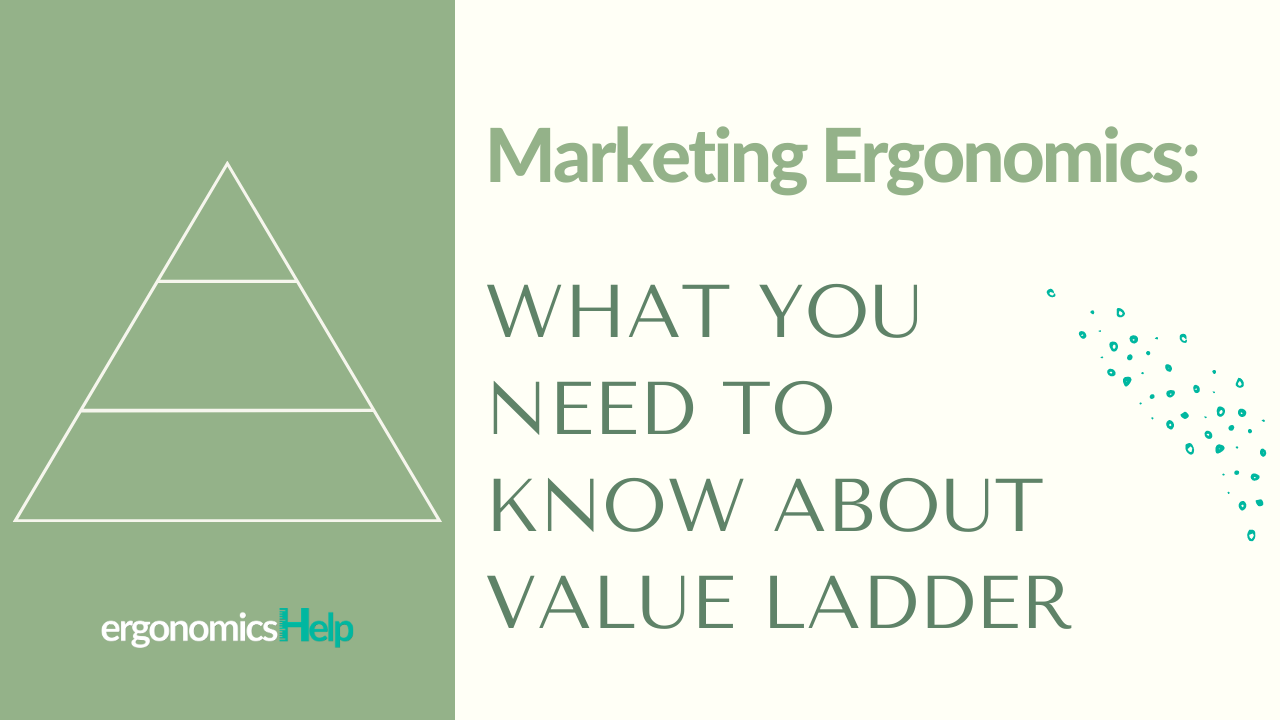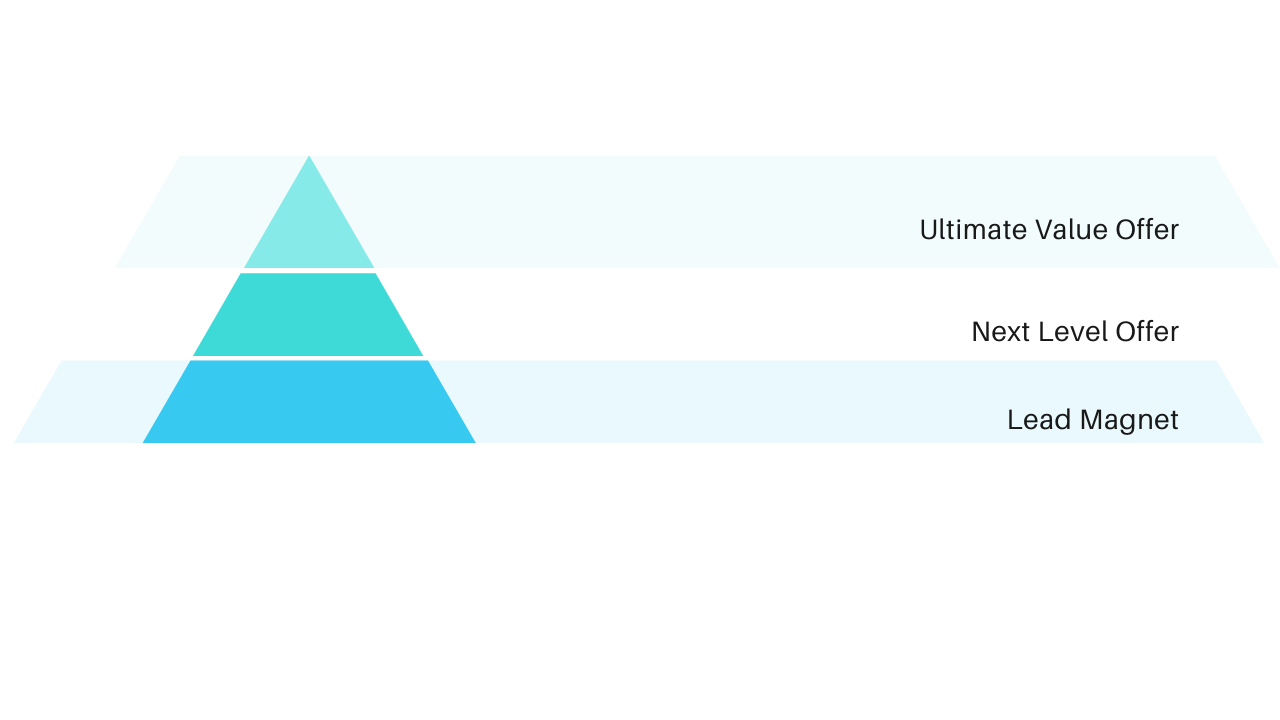Marketing Ergonomics: What You Need to Know About Value Ladder
Apr 16, 2021
Wouldn’t it be great if you could encourage your clients to move forward with all of your services? Well, in this post, I’m going to show you how to make that possible. What I’m going to talk about is something that I think is going to be extraordinarily valuable to how you run your ergonomics consulting business, even if you’re an in-house ergonomics professional. I’ll be diving into a very useful sales tactic: the value ladder. If you’ve never heard the word ‘value ladder’ before, then you’re leaving lots of opportunity to make a positive impact in your community on the table. I’ll go over how to map out a value ladder and why it's so important!
Marketing Ergonomics: What You Need to Know About Value Ladder
Have you ever said to yourself, ''I just want to focus on doing ergonomics and not market my services''? Perhaps you thought that you need to be an “expert” marketer first, or you should go to school to get an MBA degree before you can grow your services. Well, a common misconception about the ergonomics industry is that marketing our services is difficult. So what usually happens is that even if you're skilled and you love what you do, there's still a huge gap between your skill set and the value that you can bring to your communities.
So in this article, I'll show you how reframing the way we position our services will not only allow us to effectively market our services but also allow us to better serve our clients. I’ll share with you a valuable way on how to move your customers forward from just a simple “one and done” transaction to a mutually beneficial long-term relationship. What I’m going to be sharing with you is something that doesn't require you to do any sleazy sales techniques either.
What is a Value Ladder?
First of all, a value ladder is a way of mapping out your product or service offering in a way that ascends in price, from your lowest value offer (used as a hook to increase awareness and show your value) to your highest priced service. So as your clients “ascend” your ladder, the value increases, as does the price. The point of this is that not only do you have clarity of your price point and value, but it also gives your clients the clarity on what they need to move forward with first and opens up their eyes to all the ways that you can help them. A value ladder sets you up to position your services for the long-term.
Benefits of a Value Ladder
Implementing a value ladder is a passive way to promote your services and help transition those one-time customers to long-term customers. I think value ladders are a huge win-win because you're providing value to your clients on so many different aspects of ergonomics, many of which they're not even aware of. It's a really useful way to increase your profit without feeling like a sleazy marketer. Now, let’s take a look at exactly why value ladders are vital for your consulting business.
#1: Building Long-term Client Relationship
Have you ever got a huge contract to do a large amount of ergonomics consultations before? I certainly have. I like to call these huge contracts from organizations “unicorn clients.” When I was mostly doing ergonomics consulting, I could make my entire year's revenue goals in just one quarter by doing office ergonomic assessments—the most expensive type of service that I would offer at the time. Unicorn clients, like unicorns, are the ideal. They’re the sort of clients that we all want, the big organizations who not only have numerous employees that need office ergonomic assistance but have a huge budget as well. It’s a win-win situation if you have those types of contracts because there’s a real need there for someone like you to do these full one-on-one office ergonomic assessments, and they have the budget to support that. Unfortunately, unicorn clients are rare and don’t come around all the time (even nonexistent). So this is my question for you: is that really the best way for us to make a long-term revenue-generating business while making an impact that we desire?
My perspective on this matter has definitely shifted through the years of me running ergonomicsHelp and in my consulting company, in addition to coaching various healthcare professionals who want to grow their ergonomics business. What I want to say is that you’re leaving a huge opportunity for a beneficial long-term relationship for the client that doesn't fall into that unicorn description. Personally, I’d rather lose the battle to win the war. In saying this, what I mean is that I’d rather get a client to my business with a lesser price service in order to gain a long-term client. It’s much better for your bottom line that way than solely serving unicorn clients. And the great thing about the value ladder is that it promotes a long-term customer relationship that you can both continue to benefit from.
#2: Providing Valuable Options
Oftentimes, the general public has absolutely no idea about what we do as ergonomics professionals. The most common thing that I hear people say is, “Hey, can you show me how to stretch?” Or people assume that the only services that we provide are our most expensive services like one-on-one office ergonomic assessments or training. We all know that it's not a matter of if an injury is happening, but it's a matter of when, especially when someone is working from home. There are some organizations that need our help but are likely not in a position to do full one-on-one ergonomic assessments for every employee due to other operational concerns.
So the question becomes: What can we offer in terms of value to these organizations to help put out the fire and build that long-term relationship?
Who are they going to call when a Workers’ Compensation claim occurs or when someone hurts their back on the weekend and can't take the time off work? These are all opportunities that we can generate more revenue in the long run and bring more positive impact for our communities.
And who doesn't want that, right? We all want to serve our clients and make revenue. With a value ladder, not only are we thinking of what type of services we're offering to our clients, but we're looking at all the different ways we can provide value that falls outside of the typical training or one-on-one assessment.
The Value Ladder Structure
So, how do you position your services in a way that's more conducive for building a long-term relationship? How does the value ladder help you transition your prospects into loyal customers? If you haven’t noticed yet, value ladders are very similar to the value ascension pathway, and that’s because they follow the same basic idea. Both start with the majority of low-cost services at the very bottom, moderately priced services in the middle, and the most expensive services at the very top. Either way, what I want you to do is to picture your ideal client avatar’s journey.

The value ladder allows you to recognize the ascending value of your services, helping you take your customer on a journey up that ladder. You can picture it just like a triangle. It’s positioned from the lowest-cost services to the ones that have the highest profit margins.
So how do you put this plan into action?
1. The Lead Magnet
The base of the triangle will be the broader part and would have the most hits per se. This part of your ladder is where you offer freebies, such as free training or downloadable contents, to bring people into your worlds. So what you want to do is to reverse-engineer these freebies based on what your other services are and the journey that you want to take them on. The free (or very low-cost) offer serves as a hook for your prospects, which makes them much more likely to buy the next offer in your value ladder.
For instance, members of my Accelerate program use our monthly infographics. They put their logo at the bottom of it and use it as a lead generator for their business. The reason why it's so great is that it allows you to start a conversation and open a relationship. Your goal is to use this freebie as a discovery, so you can see what other services they need and use your skills to mitigate the ergonomic issues and give them a valuable solution.
2. The Next Level Offer
The middle of your triangle is where you want to make a list of your moderately priced ergonomic services. You can make a variety of offerings here, from assistance with Return-to-Work accommodations to services that are hybrids or combinations of consultations, assessments, and training. I really recommend that you spend some time here because this is probably going to be serving the majority of your audience. Your mid-range service offer generates revenue while concurrently building a relationship with your client as they get more value from you.
3. The Ultimate Value Offer
Lastly, the tip of the triangle is the most coveted spot and where your most expensive services are. For ergonomic consultants, this is usually tied to access to you. This could mean that an organization has access to your knowledge and experience at their fingertips. One option for this would include being an on-site Ergonomist for a large corporation or perhaps developing a Return-to-Work procedure. These services can be quite lucrative, and your impact can be quite large. However, you're also making a sacrifice to your business by the opportunity cost of spending all your time at this organization rather than bringing up business elsewhere.
Conclusion
So there you have it! And to end this post, let's tie this to where it first started. There are a variety of ways that you can build out your value ladder, but it starts with that freebie and figuring out what it is. To be able to transform a one-time customer into a long-term customer (the ideal), you’ll need to have something valuable to offer. I want you to think about this: it could cost you $100 to acquire a customer (either your time or ad spend), but over a lifetime of that relationship, that ongoing relationship becomes valuable.
Hopefully, this post convinced you to take action and map out your own value ladder. Want more marketing strategies and advice? Then make sure to sign up to the waitlist for the Accelerate program. You can get early access to the training series that I'll be doing before the opening of the enrollment.
